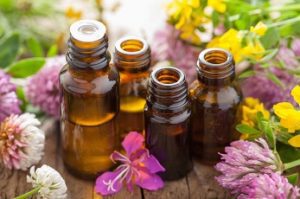Essential Oils

Education and information on the use of essential oils, Essential oils can be a great addition to your natural health program. Including a roller ball or spritzer in your daily regimen can enhance your herbal program and speed your way back to a healthier body.
This post may contain affiliate links which means that I may receive a commission if you make a purchase using these links.
As an Amazon affiliate I earn from qualifying purchases
Essential oils are another way to help the body heal and function better. Most oils are steam distilled from different parts of the plant and are very concentrated; therefore the majority of essential oils should only be used diluted and applied topically. The typical dilution for a high quality essential oil is 3-5 drops per ounce of carrier. Carriers can be oils like sweet almond oil, purchase here, grape seed oil, purchase here, hemp oil, purchase here, macadamia nut oil, purchase here or fractionate coconut oil, purchase here. One carrier I particularly like is Nature’s Sunshine’s Massage oil, (NSP stock #3928) a light, non-greasy massage and body oil featuring a blend of unscented apricot kernel oil, sweet almond oil, hazelnut oil, borage oil and vitamin E.
The only essential oil that is considered completely safe for neat (straight out of the bottle) application is Lavender. Always keep in mind that essential oils are 50 times more potent than their herbal component.
Good quality oils are ones that have not been ‘cut’ by a chemical for extraction. Many companies use chemicals to break down the raw material so the oils can be extracted easier. While they can still be labeled essential oils, they retain some of the chemicals in the final product, reducing the healing aspects of the oil, and putting unwanted chemicals into the body.
An essential oil can contain around 100 different types of volatile molecules. Some of these have been classified into larger functional groups that have predictable characteristics. The main groups are monoterpenes, sesquiterpenes, phenols, alcohols, ketones, esters, ethers, and oxides. Classifying essential oils into these chemical groups allows understanding of the basic properties and actions of individual oils. Oxides The […]
HEALING PROPERTIES OF ESSENTIAL OILS (Part 7) Read More »
Continuing on in the series of the Healing properties of Essential oils. Esters: These oils are the most balancing of all, are the safest to use, and tend to have a pleasant, fruity smell. They are commonly antispasmodic, antiseptic, and anti-inflammatory. Many esters are also sedative and fungicidal. Their balancing nature makes them particularly effective
HEALING PROPERTIES OF ESSENTIAL OILS (Part 5) Read More »
An essential oil can contain around 100 different types of volatile molecules. Some of these have been classified into larger functional groups that have predictable characteristics. The main groups are monoterpenes, sesquiterpenes, phenols, alcohols, ketones, esters, ethers, and oxides. Classifying essential oils into these chemical groups allows understanding of the basic properties and actions of individual oils. Ketones Oils
HEALING PROPERTIES OF ESSENTIAL OILS (Part 4) Read More »
An essential oil can contain around 100 different types of volatile molecules. Some of these have been classified into larger functional groups that have predictable characteristics. The main groups are monoterpenes, sesquiterpenes, phenols, alcohols, ketones, esters, ethers, and oxides. Classifying essential oils into these chemical groups allows understanding of the basic properties and actions of individual oils. Phenols These
HEALING PROPERTIES OF ESSENTIAL OILS (Part 3) Read More »

